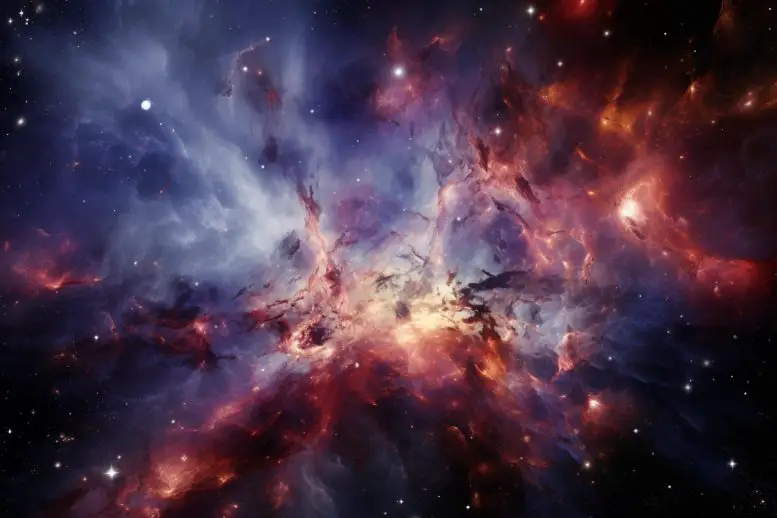Beside
” sizes=”(max-width: 777px) 100vw, 777px” alt=”Galaxy Cluster Collision Concept” width=”777″ height=”518″ aria-describedby=”caption-attachment-311886″ data-ezsrcset=”https://delecoin.com/wp-content/uploads/2023/09/The-collision-of-the-Titanic-galaxy-cluster-should-not-have.jpg 777w,https://scitechdaily.com/images/Galaxy-Cluster-Collision-Concept-400×267.jpg 400w,https://scitechdaily.com/images/Galaxy-Cluster-Collision-Concept-768×512.jpg 768w,https://scitechdaily.com/images/Galaxy-Cluster-Collision-Concept-1536×1024.jpg 1536w,https://scitechdaily.com/images/Galaxy-Cluster-Collision-Concept.jpg 2000w” data-ezsrc=”https://delecoin.com/wp-content/uploads/2023/09/The-collision-of-the-Titanic-galaxy-cluster-should-not-have.jpg” />
The collision of two massive galaxy clusters, including El Gordo, casts doubt on the predictions of the Lambda-Cold Dark Matter (CDM) cosmological model, suggesting the need to reevaluate our understanding of cosmic structure formation.
The collision of two massive galaxy clusters when the universe was half its age should not have happened according to the standard theory of cosmology, says a new study by an international group of astronomers.
El Gordo cluster
According to the standard model of lambda-cold dark matter (CDM) cosmology, galaxies form first and only later merge into larger clusters of galaxies. So galaxy clusters should take a long time to appear on the cosmic scene. A new study that was published Astrophysical Journalchallenges this by showing that two supermassive galaxy clusters collided at very high speeds when the Universe was only about half its current age.
The cluster pair in question is known as El Gordo, which means The Thick in Spanish. Aptly named because it has a mass of about 2,000 trillion times the mass of the Sun (2 followed by fifteen zeroes). The new study uses an updated estimate of this mass that is much more accurate. This removes a major source of uncertainty in an earlier study by the same authors about how problematic El Gordo is for CDM.
” sizes=”(max-width: 777px) 100vw, 777px” alt=”Composite of the El Gordo galaxy cluster” width=”777″ height=”646″ aria-describedby=”caption-attachment-311880″ data-ezsrcset=”https://delecoin.com/wp-content/uploads/2023/09/1695726573_244_The-collision-of-the-Titanic-galaxy-cluster-should-not-have.jpg 777w,https://scitechdaily.com/images/El-Gordo-Galaxy-Cluster-Composite-400×332.jpg 400w,https://scitechdaily.com/images/El-Gordo-Galaxy-Cluster-Composite-768×638.jpg 768w,https://scitechdaily.com/images/El-Gordo-Galaxy-Cluster-Composite-1536×1276.jpg 1536w,https://scitechdaily.com/images/El-Gordo-Galaxy-Cluster-Composite-2048×1701.jpg 2048w” data-ezsrc=”https://delecoin.com/wp-content/uploads/2023/09/1695726573_244_The-collision-of-the-Titanic-galaxy-cluster-should-not-have.jpg” />
Composite color image of the interacting galaxy cluster El Gordo, showing X-ray light from NASA’s Chandra X-ray Observatory in blue, optical data from the European Southern Observatory’s Very Large Telescope in red, green, and blue, and infrared from NASA’s Spitzer. Red and orange space telescope. Credits: X-ray: NASA/CXC/Rutgers/J.Hughes et al., Optics: ESO/VLT/Pontificia Universidad. Catolica de Chile/L.Infante & SOAR (MSU/NOAO/UNC/CNPq-Brazil)/Rutgers/F.Menanteau, IR: NASA/JPL/Rutgers/F.Menanteau
The mass was estimated from the deflection of light from background galaxies, which appear to be distorted in shape by El Gordo’s gravitational pull, similar to a magnifying glass. This faint lensing mass was obtained using the Hubble Space Telescope, but agrees with recent results. James Webb Space Telescope and other studies using other methods. The mass now has a modest 10% uncertainty.
Collision analysis
The study, led by PhD student Elena Asencio of the University of Bonn, used previously published detailed interaction simulations to estimate the collision rate of the clusters. The authors then searched a less detailed cosmological CDM simulation covering a very large volume to search for simulated cluster pairs. The goal was to count how many of them are broadly analogous to El Gordo just before the impact. This was done with an innovative optical computer tomography method, which takes into account that distant objects are viewed further in time when the structure was smaller.
The results showed that the strain on the CDM is very severe at every plausible collision velocity. Moreover, the residual uncertainty of the mass of El Gordos no longer plays a significant role.
Elena said: Some scientists questioned the results of our previous study after an updated mass estimate for El Gordo was released, which was slightly lower. This reduces the tension with CDM, but is still very important for any plausible crash velocity. Hundreds of detailed simulations show that El Gordo can’t look like the photos, with the much slower collision speed likely to occur in the CDM.
Although it is possible to get a simulation that looks like El Gordo with a faster collision, such an event is too rare in CDM. This is because it would be highly unusual to find two such massive clusters at such a striking distance so early in cosmic history. Reliability is further enhanced by requiring them to move towards each other at high speed. The new study and more accurate mass measurement could lead to more efforts to simulate El Gordo to better understand this enigmatic object.
Beyond El Gordo
El Gordo is not the only example of a cluster collision that contradicts the CDM. Dr Indranil Banik from the School of Physics and Astronomy at St Andrews, who developed the statistical analysis used in this project, said: The Bullet Cluster is another example of a highly energetic collision between two galaxy clusters, albeit at a later epoch. With El Gordo, the situation gets even worse for CDM. And several other examples are known and mentioned in our study.
There have also been several studies showing that individual galaxies appear to be forming much faster than expected in the CDM, thanks in large part to very recent James Webb data. Regarding the broader context of the El Gordo results, Professor Pavel Kroupa of the University of Bonn and Charles University in Prague said: There is now a lot of evidence that the formation of structures in the universe happened faster than expected in the CDM. We are currently investigating other evidence for this.
Reference: Elena Asencio, Indranil Banik, and Pavel Kroupa Challenges the CDM for Every Plausible Collision Velocity by Elena Asencio, Indranil Banik, and Pavel Kroupa, 4 Sep 2023, Astrophysical Journal.
DOI: 10.3847/1538-4357/ace62a
#collision #Titanic #galaxy #cluster #happened #violates #theories #cosmology
Image Source : scitechdaily.com
